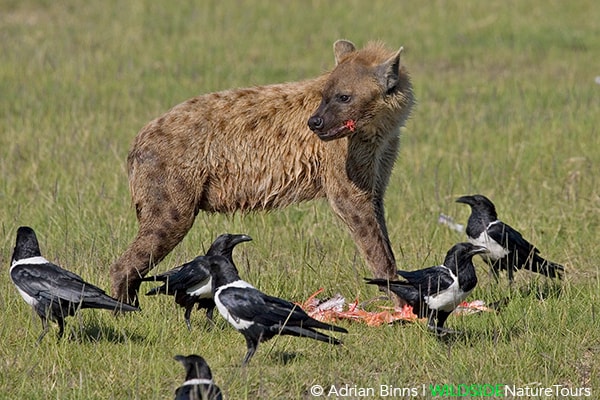Across the wild landscape of Africa, life and death are in constant play. Every creature must eat, and the survival of one often depends on the demise of another. Big cats like lion, leopard, and cheetah are the dominant predators of the savanna, hiding in tall grasses or dense thickets to ambush prey. These hunters work hard for their meal, and eat quickly as scavengers are never far away.
Scavengers play an important role in the eco-system. Cunning strategies serve them well, ensuring food distribution for a variety of animals, and keeping disease at bay. Jackals and hyaenas jump quickly into fresh kills, risking peril to snatch morsels away from the triumphant hunter. Vultures and Marabous scavenge more patiently, waiting for less frenzied moments to grab a bite, often joined by Pied Crows, Tawny Eagles, and Yellow-billed Kites. Scavengers possess strong digestive systems to eat not only fresh meat, but carcasses of animals that died of natural causes.
Both predators and scavengers are creatively opportunistic. Carnivores may try to steal another’s hard-earned meal, and some scavengers are adept hunters themselves. Herbivores such as zebra, wildebeest, buffalo, giraffe, and impala are ever-alert while grazing. When the youngest and weakest fall prey to a hunter, they serve many creatures. Nothing goes to waste on the African plains.

Spotted Hyaena with Pied Crows
Hyaenas are clever carnivores, adept at hunting for a meal themselves, or scavenging another’s kill. Spotted Hyaenas live in clans and can drive lions away from their meal. Hyaenas have specialized powerful jaws to crush bones, and remarkably strong digestive tracts to eat just about anything. A diet including bone marrow produces white scat.

African White-backed Vultures at carcass, with Hooded Vulture waiting
Vultures are crucial cleaners of the natural world. These avian scavengers consume only dead animals, and may gorge themselves to the point that they can’t lift off in flight. Multiple vulture species cluster around large kills, each adapted for a different role. The huge Lappet-faced Vulture has a bill strong enough to rip open tough leather hides; White-backed and Ruppell’s Vultures tear chunks of flesh; the smaller Hooded Vulture cleans up the last bits, leaving only remnants for invertebrates.

Black-backed Jackal eating Lesser Flamingo
Jackals often roam the savanna in pairs. Black-backed Jackals are the most commonly-seen members of the canid family on our safaris. They will hunt small game, but will also try to grab a quick bite before hyaenas, other cats, and vultures arrive on the scene of a fresh kill.

Marabou stealing a meal from Black-backed Jackal
Marabou storks often join in cautiously after vultures have arrived on the scene. They pace slowly in a circle, looking for an opportunity to step in and grab what they can without getting hurt in the melee. They are patient and daring scavengers.





































